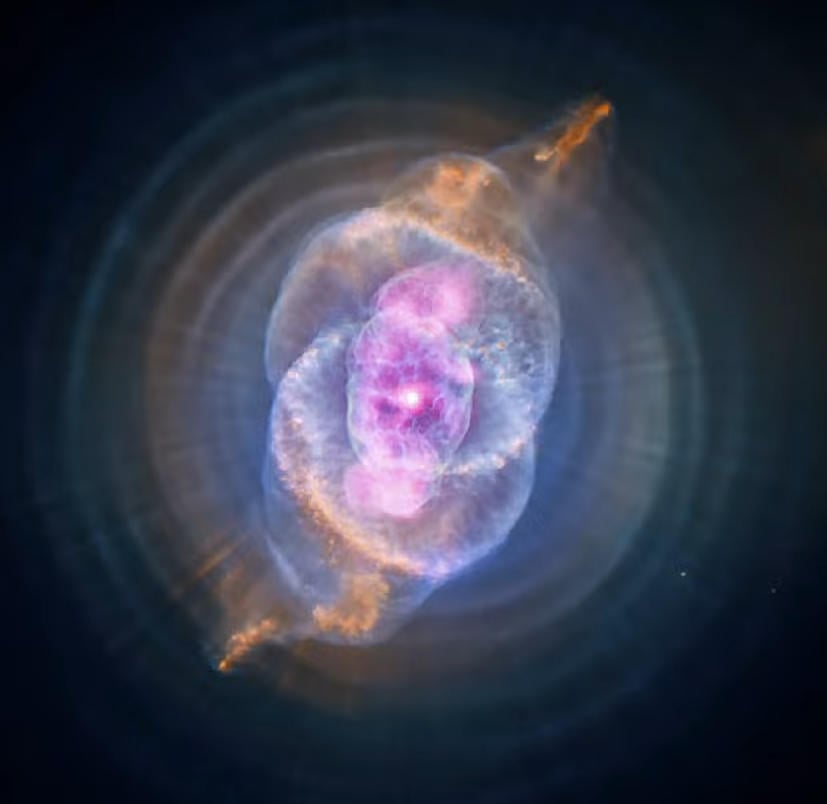Snímek mlhoviny Kočičí oko pořízený Hubbleovým vesmírným dalekohledem. Poděkování: NASA/CXC/SAO/K.Arcand, SYSTEM Sounds (M. Russo, A. Santaguida)
Astronomové objevují v mlhovině Kočičí oko prstence s téměř dokonalou symetrií
Vědci sestavili první počítačově generovaný 3D model mlhoviny Kočičí oko, který odhaluje pár symetrických prstenců kolem vnějšího pláště mlhoviny. Symetrie prstenců naznačuje, že byly vytvořeny tryskovým proudem pocházejícím z centrální hvězdy mlhoviny. To poskytuje silný důkaz pro dvojhvězdu ve středu mlhoviny. Studie byla nedávno publikována v časopise Měsíční oznámení Královské astronomické společnosti Vedl ji Ryan Claremont.
Planetární mlhovina vzniká, když umírající hvězda vyvrhne svou vnější vrstvu plynu a vytvoří barevnou strukturu podobnou skořápce, která je charakteristická pro planetární mlhoviny. NGC 6543 neboli mlhovina Kočičí oko je jednou z nejsložitějších známých planetárních mlhovin. Je vzdálena jen něco málo přes 3000 světelných let od Země a lze ji vidět v souhvězdí Draka. Mlhovina Kočičí oko byla také velmi podrobně viděna[{“ attribute=““>Hubble Space Telescope, exhibiting a complicated structure of knots, spherical shells, and arc-like filaments.

A side-by-side comparison of the three-dimensional model of the Cat’s Eye Nebula created by Clairmont and the Cat’s Eye Nebula as photographed by the Hubble Space Telescope. Ryan Clairmont (left), NASA, ESA, HEIC, and The Hubble Heritage Team (STScI/AURA) (right) (CC BY-NC-SA 4.0).
The nebula’s mysterious structure confounded astrophysicists because it could not be explained by previously accepted theories for planetary nebula formation. More recent research showed that precessing jets were potential shaping mechanisms in complex planetary nebulae such as NGC 6543, but lacked a detailed model.
Clairmont, an astronomy enthusiast, decided to try to establish the detailed 3D structure of the Cat’s Eye to find out more about the potential mechanism that gave it its intricate shape. To do this, he sought out the help of Dr. Wolfgang Steffen of The National Autonomous University of Mexico and Nico Koning from the University of Calgary, who developed SHAPE, 3D astrophysical modeling software particularly suitable for planetary nebulae.
The researchers used spectral data from the San Pedro Martir National Observatory in Mexico to reconstruct the nebula’s three-dimensional structure’s three-dimensional structure. These provide detailed information on the internal motion of material in the nebula. Together with these data and images from the Hubble Space Telescope, Clairmont constructed a novel 3D model, establishing that rings of high-density gas were wrapped around the outer shell of the Cat’s Eye. Surprisingly, the rings are almost perfectly symmetric to each other, suggesting they were formed by a jet – a stream of high-density gas ejected in opposite directions from the nebula’s central star.
The jet exhibited precession, similar to the wobbling motion of a spinning top. As the jet wobbled, or precessed, it outlined a circle, creating the rings around the Cat’s Eye. However, the data indicates the rings are only partial, meaning the precessing jet never completed a full 360-degree rotation, and that the emergence of the jets was only a short-lived phenomenon. The duration of outflows is an important piece of information for the theory of planetary nebulae. Since only binary stars can power a precessing jet in a planetary nebula, the team’s findings are strong evidence that a system of this type exists at the center of the Cat’s Eye.
As the angle and direction of the jet changed over time, it likely formed all of the features seen in the Cat’s Eye, including the jets and knots. Using the three-dimensional model, the researchers were able to calculate the tilt and opening angle of the precessing jet based on the orientation of the rings.
Ryan Clairmont, the lead author of the paper and now a prospective undergraduate at Stanford University stated, “When I first saw the Cat’s Eye Nebula, it was astonishing. It had a beautiful, perfectly symmetric structure. I was even more surprised that its 3D structure was not fully understood.”
He continued, “It was very rewarding to be able to do astrophysical research of my own that actually has an impact in the field. Precessing jets in planetary nebulae are relatively rare, so it’s important to understand how they contribute to the shaping of more complex systems like the Cat’s Eye. Ultimately, understanding how they form provides insight into the eventual fate of our Sun, which will itself one day become a planetary nebula.”
Reference: “Morphokinematic modelling of the point-symmetric Cat’s Eye, NGC 6543: Ring-like remnants of a precessing jet” by Ryan Clairmont, Wolfgang Steffen and Nico Koning, 15 September 2022, Monthly Notices of the Royal Astronomical Society.
DOI: 10.1093/mnras/stac2375

„Unapologetický analytik. Rozzuřeně skromný kávový evangelista. Hráč. Nelze psát s boxerskými rukavicemi. Student. Podnikatel.“
You may also like
-
„Ďábelská kometa“ 12P/Pons-Brooks míří ke Slunci. přežijete?
-
Potraviny a nápoje, které podle lékařů způsobují bolesti kloubů
-
Jádro Pluta bylo pravděpodobně vytvořeno starověkou srážkou
-
Vědci z UF doufají, že zastaví smrtící bronzovou chorobu u palem na Floridě
-
Odhalení tajemství struktury mozku u autistických pacientů

